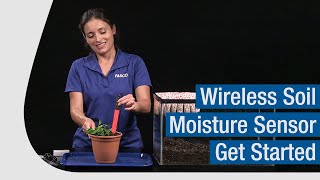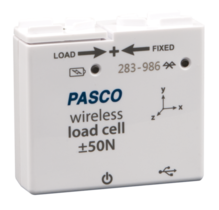The Wireless Soil Moisture Sensor measures the volumetric water content (%VWC) of soil, reporting data in real time or storing it onboard the sensor's memory for long-term monitoring and investigations.
Product Summary
The Wireless Soil Moisture Sensor measures the volumetric water content (%VWC) of soil, reporting data in real time or storing it onboard the sensor's memory for long-term experiments. Durable and easy to use, the Wireless Soil Moisture Sensor is the perfect tool for monitoring controlled experiments in the classroom and long-term experiments outdoors. From experiments in evaporation and soil composition to water consumption and plant competition, the Wireless Soil Moisture Sensor makes it easy for students to investigate a wide array of topics both inside and outside of the classroom.
To use the sensor, dig a trench a few inches below the ground's surface and place the sensor's spear-shaped portion in the soil. Be sure to pack the soil tightly around the sensor for best accuracy. After use, the surrounding soil should be loosened to reduce the risk of damaging the sensor's cord.
Features
- Collect and display data in real time within PASCO Capstone or SPARKvue software
- Automate data collection for hours, days, or weeks with Logging Mode
- Bluetooth connectivity enables use in the classroom, lab, or field
- Supports use of GPS data from a mobile device for GIS mapping activities
- Selectable calibrations for predominantly sandy soils, clay soils, and loamy soils
Applications
- Monitor soil moisture content to control irrigation in greenhouses and gardens
- Measure changes in soil moisture over time due to evaporation and/or plant uptake
- Investigate the effects of different land covers on soil moisture retention in xeriscaping
- Determine the optimum soil moisture content required for plant species to germinate
- Investigate the relationship between soil moisture content and heat stress in plants
- Explore the effect of moisture on mold growth in food sources
- Combine with GPS data from a mobile device and soil moisture data to an online map for GIS activities
How It Works
The Wireless Soil Moisture Sensor determines the percent water content by volume of soil by measuring the dielectric constant of the space around the blade-shaped capacitor. An electric field generated by the sensor responds to the capacitance of the surrounding space and uses the response to calculate the soil's percent water content per volume.
Liquid water has a uniquely high capacitance, making it the predominant contributor to the sensor's measurement. The sensor comes factory-calibrated for soils with discreet values of volumetric water content and outputs readings in percentage of total space filled. Accurate readings range from 0%, in which there is little to no moisture in a dried sample, to 45%, in which all the available pore space within the soil is saturated with water. For a % saturation reading, divide the value by 45.
The sensor has been calibrated to support analyses in 3 of the predominant soil types: sandy soils, clay soils, and loamy soils. If you are unsure of your soil type, select the intermediate calibration, loamy soil which works for the broadest conditions.
Product Specifications
| Range | 0 to 45% water by volume |
| Resolution | 0.1% |
| Accuracy | ±5% |
| Operating Temperatures | -40 to 60°C |
| Power | 3 mA at 5 V DC |
| Probe cable length | 2 m |
| Connectivity | USB and Bluetooth 5.2 |
| Logging | Yes |
| Battery Type | Rechargeable LiPo |
Battery & Logging
| Data capacity | > 55,000 data points |
| Battery | 3 - 5 days on single charge depending on sample rate |
| Battery Type | LiPo |
1 Minimum # of data points with all measurements enabled, actual results depend on enabled measurements.
2 Continuous use in a connected state until battery failure, actual results will depend on sample rate, active measurements, and battery condition.
3 Logging until battery failure, actual results will depend on sample rate, active measurements, and battery condition.
* Normal classroom use is the sensor in active use for 20min/lab for 120 lab periods/yr.
Data Collection Software
This product requires PASCO software for data collection and analysis. We recommend the following option(s). For more information on which is right for your classroom, see our Software Comparison: SPARKvue vs. Capstone »
Connectivity Options
This product can connect directly to your computer or device with the following technologies. No Interface required. See the following guide for details regarding device compatibility: Wireless Bluetooth Product Compatibility »
Dedicated Datalogging with SPARK LXi2
Consider an all-in-one, touchscreen data collection, graphing, and analysis tool for students. Designed for use with wired and wireless sensors, the SPARK LXi2 Datalogger simultaneously accommodates up to five wireless sensors and includes two ports for blue PASPORT sensors. It features an interactive, icon-based user interface within a shock-absorbing case and arrives packaged with SPARKvue, MatchGraph!, and Spectrometry software for interactive data collection and analysis. It can additionally connect via Bluetooth to the following interfaces: AirLink, SPARKlink Air, and 550 Universal Interface.
Product Guides & Articles
GIS with SPARKvue
Whether you’re introducing students to microhabitats, monitoring water quality, or conducting field work, the SPARKvue Map display unlocks a new world of spatial insights for you and your students to explore.
Experiment Library
Perform the following experiments and more with the Wireless Soil Moisture Sensor.
Visit PASCO's Experiment Library to view more activities.
Soil Type and Surface Moisture
Students use a soil moisture sensor to determine the surface evaporation rate for three different soil types and a mixed soil sample.
Plant Growth and Water Content
Students use a soil moisture sensor to determine the ideal moisture level for optimum plant growth.
Soil Moisture Field Study
In this field study, students use a soil moisture sensor and an on-board GPS sensor on their mobile device to determine the ability of soil to hold and absorb water across a transect of land based on a class set of measured volumetric...
Support Documents
| Manuals | ||
|---|---|---|
| Wireless Soil Moisture Manual | English - 501.04 KB | |
| Safety Sheets | ||
| Lithium Battery Safety Data Sheet | English - 593.56 KB | |
| Knowledge Base | ||
| How do I troubleshoot connecting a wireless sensor? | Aug 22nd, 2022 | |
| Windows asks for a PIN number when connecting wireless sensor or device | Sep 18th, 2023 | |
| Wireless sensor or device not charging | Mar 4th, 2024 | |
| Android asks for a PIN number to pair a wireless device to system | Aug 29th, 2023 | |
| Battery replacement instructions for PS-3228 | Aug 7th, 2023 | |
| Tips for use of micro USB cables | Aug 29th, 2023 | |

















